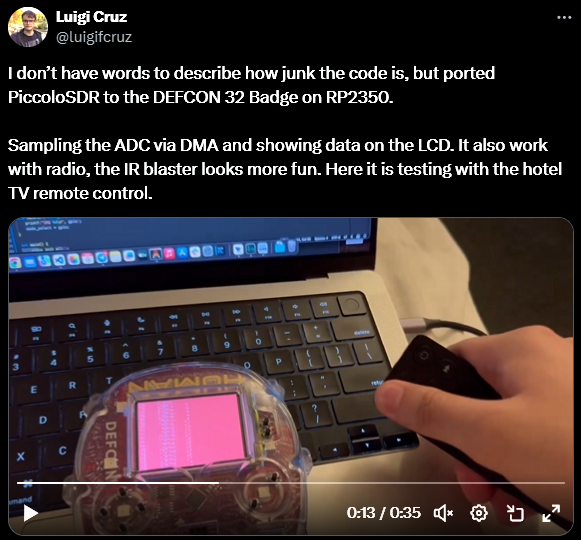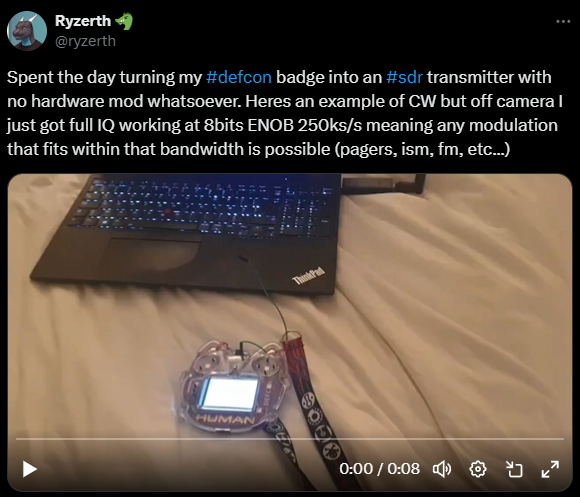This week in DragonOS…
Highlight of the Week: DEFCON32 is in the books…
Highlight of the Week: DEFCON32 is in the books
Thanks to everyone who hung out at DEFCON this year! A special thank you to the RF Hackers Sanctuary (RFHS) for allowing Cemaxecuter to help out, congratulations to team “WhatTheFreq!” on the CTF win. With the electronic badge that was handed out to DEFCON32 attendees this year, we were bound to have some cool radio-related hacks. The CyberEther developer managed to load PiccoloSDR on the badge: https://x.com/luigifcruz/status/1822147866262913196

If PiccoloSDR isn’t for you, the SDR++ developer turned his badge into a basic SDR transmitter: https://x.com/ryzerth/status/1822217530238439877

It was good meeting up with everyone and next year is bound to be even more fun. As radio and SDR-related talks are posted on RFHS YouTube and other places, this post will update accordingly – all that seems to be available currently is a talk that was delivered on reversing the GoTenna: Mobile Mesh RF Network Exploitation: Getting the Tea from goTenna
BladeRF Power Meter
A RF power meter is a device that is used to accurately measure signal strength. These devices are useful for calibrating the exact amount of transmit power for regulatory compliance, or characterizing received power at a certain location to ensure safe levels for sensitive equipment and people. If you don’t want to spend the money on a device that only acts as a power meter, it is possible to have your BladeRF act as a power meter and an SDR…for a price. You will need to have your BladeRF 2.0 calibrated in order for it to function as an accurate power meter because every device’s frequency response is slightly different and requires unique adjustment. You can read more about the process for calibration on Nuand’s blog post. It is not clear whether new BladeRF 2.0 micros from the factory will come with the calibration files already or if the calibration service will always be an extra requirement. It is also uncertain how sensitive devices are to calibration files. If a calibration file provides enough granularity when applied to a separate BladeRF, it is possible that future versions of DragonOS may ship with the calibration files pre-installed. With that being said, the highest degrees of accuracy will always be achieved through individualized calibration. Cemaxecuter was able to get his BladeRF calibrated at DEFCON32 and the power meter seems to work very well: https://x.com/cemaxecuter/status/1822138016434966812

Explore More with DragonOS
- DragonOS Source for x86_64 systems: https://sourceforge.net/projects/dragonos-focal/
- Download the latest release of DragonOS for x86_64 systems, ask for support, and read about the history of DragonOS.
- DragonOS Source for Pi64 systems: https://sourceforge.net/projects/dragonos-pi64/
- Download the latest release of DragonOS for Pi64 systems, ask for support, and read about the history of DragonOS.
- Cemaxecuter on YouTube: https://www.youtube.com/channel/UC9U2kaqhE716J2WNSTcOghg
- Follow along with Cemaxecuter himself as he walks you through how to use specific SDR tools within DragonOS and explains why they are valuable.
- DragonOS Discord Channel: https://discord.com/invite/cYuS3E3k
- Join the community of DragonOS users to share your work, ask for help, or lurk for content
- Cemaxecuter on X: https://x.com/cemaxecuter
- Recent updates from the creator of DragonOS
- DragonOS Patreon: https://www.patreon.com/cemaxecuter
- 100% of contributions fund advanced features, videos, and hardware. As a thank you, Cemaxecuter will ask for your feedback on experimental features.
- For collaboration please contact cemaxecuter directly at cemaxecuter@protonmail.com